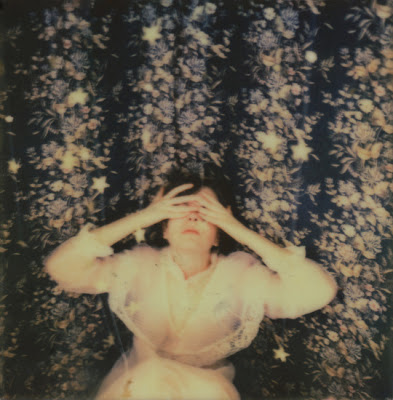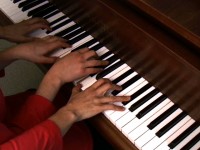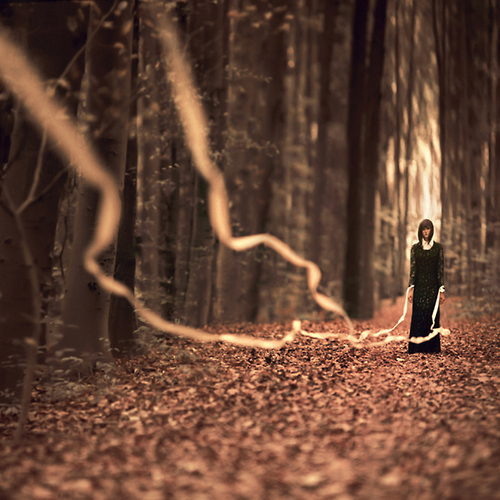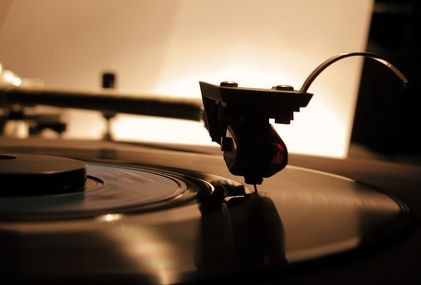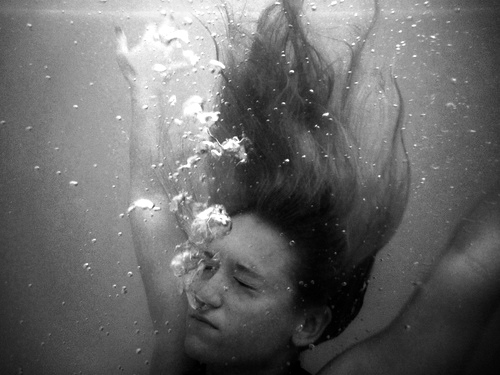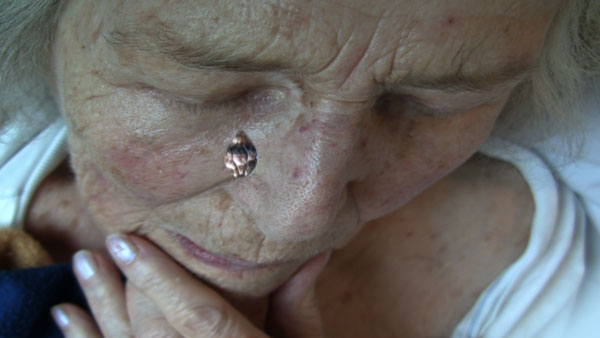
Gunilla Josephson in conversation with Cameron Bailey
On the occasion of her show “3 Lies”
at Archive Inc. Gallery
26 Berkeley Street, Toronto, Canada
June 24, 2006
From the press release:
Archive Inc. is pleased to present My Lies, three video works by artist Gunilla Josephson. As “fictional histories” these videos are perceptual chronicles of experience, in which history is the result not of facts, but of perceptions.
Artist’s Talk
Cameron Bailey: I’ve been following Gunilla’s work for many years so I’m glad to be here to talk about it with you in person, particularly The Blood Red Heart of Johanna Dark (68 minutes 2006). The first thing I want to ask is who is Johanna Dark?
Gunilla Josephson: She’s composed of two historical characters, the one we know and a Resistance fighter from 1939. She is a hanger for my work that is about history and architecture and my own personal self. Whether Johanna Dark existed or not is an open question. I think she did. I am looking for her.
CB: Were you working from actual historical sources or was this an invention?
GJ: Neither one nor the other. The meeting between ‘the one we know’ and the Resistance fighter from 1939 is clearly fictitious. I did enough research to be able to substantiate some of the truths/lies in the film. But the work also derives from my four-month residency in a Paris studio in 2003. I started to imagine someone else who was either coming with me or who was already there. She was taking my place and I was taking hers, we were going back and forth, and that’s how she was created. I started to give her a wardrobe and her own things, starting with one of these bags they carried in the Resistance. It grew into a film about the Resistance, but very much a story as if… I’m here and what if… I’m here what if I’m somebody else? If I’m here with the Resistance what if… this is another time.
CB: Paris really is one of those cities where you can feel layers of history as you walk through it and live in that architecture. In the film you layer present day Paris with Paris from the 40s, and of course there are echoes of Joan of Arc. Can you talk about the levels of history you wanted to work with?
GJ: Well, there are psychological, physical and historical levels I wanted to include. On a psychological level Paris gives me an experience of alienation and in that sense the work is about the alienated self. It has personal roots because of how my life was at a certain time in Paris. On a physical level it is about Paris itself, which I find extremely oppressive in the sense that I feel wings of history flapping around my head, obstructing a clear view and making it difficult to separate myself from the old stones of buildings, which become the street, which become us. I think the film shows this kind of circularity/implosion. My work turns into itself, just like the city of Paris. And there are certain ideas around history as not necessarily linear, but that is another story.
CB: Why was the French Resistance important for locating this character?
GJ: Johanna Dark meets Joan of Arc because they are both female warriors. I like to work with history that way. I make up my own history, which is just another lie and this lie becomes part of a history of lies. It also relates to the infrastructure of the city. Pére Lachaise is the place where they shot Resistance people against certain walls, while the underground Catacombs hid the Resistance fighters. At the same time these are tourist sites, so as I’m showing Paris I’m talking about the history and also about myself.
CB: The cemetery of Pére Lachaise also hosts altars to Jim Morrison and others.
GJ: It’s a wonderful place because you have them all there, philosophers, the ordinary people, artists, and musicians. A layered and ‘lively’ place. In a spiritual sense.
CB: And what about Notre Dame which also figures largely? You show both the physical structure and a toy version, it’s really lovely when you superimpose one with the other, the kind of layering you use.
GJ: My fascination with Gothic cathedrals started a long time ago. In my own distress, in my personal history, I have spent time alone in Notre Dame. The cathedral satisfies my own desire for beauty as a consolation for distress.
CB: So you’re able to divorce a cathedral from what it actually does, and just see it as a place of architectural beauty?
GJ: I can do that, but I also like to possess the world by working with the miniature, the model. Once I can put it in my pocket it’s not threatening anymore, it’s de-constructed, or put down, so to speak. I also use the model as a way for Johanna Dark to travel from Quebec to Paris, you know these old tropes in film where you travel through a montage. I was trying to find a way for her to go to Paris without spending too much money..
CB: Cinema has long figured in your practice, for instance you’ve made a very well known piece called Hello, Ingmar (7 minutes 2000) about Bergman’s work and your intervention into that body of pictures. I wonder what is your relation to cinema? Do you consider yourself working inside it or are you at a slight angle to the way cinematic tropes work? Are you making a movie or are you making something that’s about movies?
GJ: I have a great interest in film and the theatricality which exists in film. I am convinced that films can be made very differently than they are today. I guess I’m working in resistance to conventional filmmaking. I use the camera as an extension of myself, I’m interested in creating an in-your-face production, and I don’t know if you call that cinema…
CB: Cinema can be many things…
GJ: I don’t really know, could you tell me?
CB: I’m hardly the person to tell you right now. I’m interested because we’re here in a gallery, this is obviously something made as an installation for a white box but could it also show in a black box, in a cinema? You have a protagonist, a heroine, you have other characters and a kind of story, at what point does it depart from being a movie?
GJ: It depends on how you define a movie. If a movie requires a standard format and viable economics then Johanna Dark is not a movie. There is no success like failure, and failure is no success at all, as Bob Dylan says.
I started by saying to my partner I’d like to ‘make a movie.’ How do you do that? I approached the idea with a deliberate naiveté, not as a method but as a desire I had. I understood at once that I had to have a story/narrative, not a vehicle I had used to convey my ideas before. Now it’s up to the viewer and the critic to decide if I ‘made a movie,’ or not. If it is not a movie, what is it? I’ve made this monster and I’m not sure where it stands. I had a movie night at the theatre of The Swedish Cultural Centre in Paris, where we had done some of the filming. I asked the people at the local movie theatre where we spend time in France, if they would put it on for us, as an experiment. Lewis and I were the only ones in the theatre and thought it was quite good.
CB: That’s a good start, you have to like it.
GJ: This is very much what it is about. Desire. It meant for example that I was not willing to get permission to film anywhere. That didn’t seem like fun.
CB: In the Louvre for instance.
GJ: It was very interesting to find out how far you could go without permission.
CB: You and The Da Vinci Code shooting in the Louvre, that’s a great idea.
GJ: At the Louvre we shot a scene in front of one of the paintings, Pierrot/Gilles by Watteau. We came into the museum with a bag of clothes and the actor took her jeans off and put her costume on. She’s half dressed in the scene and begins to dance in front of this painting. I thought let’s just do this until something happens and then the guard came up and said, “Vous voulez une chaise?” Would you like a chair? Yes, that would be very nice. I did not get the resistance I would have liked to have.
CB: The guard at the Louvre let you keep shooting.
GJ: Yes, and this shows you how big movie making is, because what I made was absolutely no threat, but if you make A Movie you come in with trucks and need permission. When we shot in the Catacombs eight of us went down separately, one with a light, another with a camera, and then we met and did some fast shooting. A guard came down and said you cannot use lights in here, so we turned it off and everyone said we have to leave. But I said let’s just do it once more and the guard never came back, though he knew we were still there. I think he just felt he had to say something.
CB: One of the things I liked about the Louvre scene is that there’s a real sense of play in her performance. A lot of your work uses games, whether it’s Loves Me Loves Me Not (2:42 minutes 2003), or dress up games. What is the appeal of childhood play in your work?
GJ: (pause) I’m not pausing because I have a block, I’m trying to give you a good answer. It’s a rebellion against the orthodoxy of Being Grown Up. Even artists, I find, are fairly conventional people and art is usually not so outrageous. I am drawn to play and the fairy tale, and subsequent subversions. Perhaps it’s a way of crushing our ideals surrounding family and gender roles; maybe this comes naturally to today’s post-post feminist deconstructivist. Contrary to what you might think, I grew up in a conventional world in Stockholm, where my kind of free-floating imagination was not encouraged.
CB: Did parents or teachers try to get in the way?
GJ: There was a social democratic oppression of sorts at that time in Sweden, with a tendency toward conformity and a fear of originality and individualism. There was nothing really wrong with this system, but in the cold North… I’ve always felt more like a Mediterranean on the inside, a Swede ‘on the outside.’ When I grew up I liked theatricality, costumes, melodrama and opera; not only as story telling, but as imaginative work around humanity. In Sweden theatre and film are highly developed, the same people work in both traditionally. For example Ingmar Bergman.
CB: You cast Benny Nemerofsky Ramsay to play a character who becomes Pierrot. For me there are two forces at play, there’s a free spontaneous interruption but there’s also rules. Games always have rules.
GJ: My games become ritualistic and threatening. You need to break the rules. The unexpected happens. The outcome surprises, unnerves. And frees…
CB: But every game needs to start with rules and then you can improvise.
GJ: Have you seen a thread there in my work, I’m not sure.
CB: I see games in a lot of your work, yes.
GJ: Do we follow the rules?
CB: Good question.
GJ: Lewis, what would you say?
Lewis: I’m not sure what you mean by rules. Do you mean the medium sets rules, and what Gunilla does within that is playful? She tries to break those rules, but I don’t know how that relates to rules of play.
CB: I’m thinking for instance of the meeting between Johanna and Benny’s Pierrot character. They immediately start dancing; there is a kind of common ground which is agreed upon when any two people start to play. What usually happens, between children anyway, is that someone gets upset when someone breaks the rules, and then you have to start again with new rules. I’m wondering if that’s a design element in your work or does play enter for the sake of spontaneity?
GJ: No, it’s not spontaneity. It’s usually… the reason I use Pierrot and costumes from the 1700s or Mozart, and a woman from the 1940s, etc., is that they all represent something and by combining them, the context is undermined and the meaning changes. This is where my work is a bit like a rebus. You have to read it. Pierrot merges into the Resistance worker who becomes Pierrot again. Then Johanna goes to visit a painting of Pierrot in the Louvre where she becomes Pierrot. It is a creative associative process. It’s not a play for me, but it comes out as mental dances that means something, not one thing, but a string of clues.
CB: It’s a process of invention, which also takes you from one scene to the next.
GJ: Hmmm… Maybe. My friend and colleague in arms Benny Nemerofsky Ramsay epitomizes Pierrot. Benny as Pierrot signifies sadness, melancholy, poetry, longing and also the tragedy of war. Pierrot becomes Etienne the Resistance Fighter, who is a look-alike Jean Moulin, the real and greatest French Resistance hero. This film is about the alienated self, and about sadness and the paranoia of war. That’s how I personally relate to this work, and the spirit in which I have created it. But I accept all interpretations and welcome them.
CB: Let me ask you about the scene we are now watching which shows the twinned woman, the doppelganger, who is playing the piano with Johanna. There’s a recurring image of twinned women in your pieces, what’s in that for you?
GJ: (pause)
CB: You really think about these answers don’t you?
GJ: (laughs) Yes, I haven’t seen the questions before. One thing is that it’s a weird exuberance; I never find that one is enough. I’m hungry I guess.
CB: Two is better?
GJ: Two is better than one, three would be even better! Visually at least! Seriously though, psychologically it represents the divided self, they are my alter egos, and maybe there are two of them. One allows you to have pleasure, the id, while the other is the superego, policing the ego/id. They can have fights like in Happy House: The id, the Kid and the Little Red Fireman. Or in A Clean Sweep (18 minutes 2001), where Hedda, my alter ego, encounters a religious (looking) woman in a mirror, both played by Anna-Lena Johansson, the performer in most of my videos. They have a horrible fight because Hedda is de-re-constructing the whole world and the woman in the mirror says you can’t do this.
In the piano scene Two signifies younger and older. The older person gives support and teaches while the younger one conforms in order to learn. Complicated. I am not sure. Here I also think my visual ‘appetite’ has taken over.
The events of the Johanna Dark movie never happened but they’re happening now, it’s a state of mind in a state of war, it’s about war paranoia. The work is about existential fear, the possibility of war, not literally war, but violence and being outside of society and not functioning in it. Being an émigré like me you don’t fit in anywhere. I left Sweden because I was a stranger of sorts, so it doesn’t seem to matter where you are… but I’d like to think I’m not the only one who fumbles.
CB: You’ve expressed a lot of ideas just now and in this piece: war, religion, and the divided self, history, art, there’s all of these things going on. What I want to ask you now is about process. For me it feels like an assemblage, an aggregation of images and ideas that have come together, but I wonder what you started with and what was the process of fitting together all these ideas?
GJ: There is not an ounce of randomness in this work, if that is what you mean by assemblage and aggregation of images. There is a decision behind and a reason for every single image and scene, either as part of the storyline or as part of the larger spectrum of content. We shot 64 scripted scenes. Later, in the editing process, the first thing we did was to create a simple story, as the skeleton or armature for the extended story, so to speak.
As I explained, I wanted to see if it was interesting and possible for me to do A Narrative Art Work. For my four months Canada Council Paris Residency, I found a young French student who wanted to work with me, and there were some great friends from Canada and Sweden, and London, who came to Paris at different times, so that altogether we had a cast of eight people. And then I had Lewis who is my cameraman and collaborator on the script. He pushed me all the time to remember the story, which was good. I’m an image-maker, I’m very interested in image, and was extremely energetic in my findings in Paris. On the whole we filmed too many things, too many times, but better too much than too little..
CB: Was there a point where you wanted to put everything in, everything that struck you?
GJ: I have sixty or seventy hours of footage, but I realized I absolutely needed the rigour of a story, even if it meant sacrificing some great imagery. Though the story is not what this work is finally about, I knew how I had to edit to get to the core of the humanity of the work. I look at filmmakers like Tarkovsky and Sokurov, Goddard and Antonioni, who put together images to explain or tell something in a different way. It’s a little bit hard to talk about the process because I know I frustrate the people I work with in many ways. It’s very demanding because I know exactly what I want but not before hand.
CB: (laughs) That’s completely normal, by the way.
GJ: Lewis was instrumental; he would get nervous when we looked at the dailies. He would say you need a script for tomorrow and we need to write it now. This allowed us to stick to this simple story: A nun from Quebec comes to Paris in 1939 to study architecture and art and becomes involved in the Resistance movement and perishes. On one level Johanna Dark is a typical story from the Resistance films that I discovered only afterwards and found very bad in general; without an aspiration toward truth or originality. Movies like these are politically dangerous because they are so very simplistically heroic. According to these films everyone in France was in the Resistance, at least for the last ten minutes of the war… All clichés. I was never interested in these films, but as I started making my own, I realized that I have many received images because I am part of a generation that grew up after the war. I knew what I needed to make it resemble a Resistance movie. I became interested in looking at these clichés to see what they actually contain, aiming at dismounting them as monuments. For example when I use these big (LP) records for codes, it’s obviously ridiculous, they’re too large, and what happens if they break? In the film they become a symbol for something else.
CB: You’ve mentioned Lewis a couple of times. Lewis, I know you’ve worked on many pieces with Gunilla, I’m curious about working together on this piece in particular. When you are serving as an editor, how do you know when something fits and when it doesn’t?
GJ: Lewis edited the story with Aleesa Cohene, but in general he is not part of the editing process.
Lewis: When I liked the shot and it fit, often afterwards Gunilla would destroy it. I was very linear, I wanted a script, where’s the camera going to be, what are the people going to do? My way of filming is quite conventional. What you’re seeing mostly is what happened afterwards when Gunilla chopped the footage up in the editing suite. I would put the camera in the centre of the floor and have the action happen right there. Gunilla is always grabbing the camera and running around. It worked well because I made stuff that she could remake. When I look at the film now I don’t clearly see my part in it.
CB: Is he any use to you at all then?
GJ: (everyone laughs) He’s useful because I can deconstruct and reconstruct what he makes.
CB: You mentioned the cathedral, I wanted to go back to your use of physical spaces: the Louvre, the Art Gallery, the Cathedral, and the streets of Paris. I wanted to ask what it means for you to use physical space generally, what it means to inhabit a place with a camera because as you say you don’t like to simply set the camera up and record, you’re moving through space with it.
GJ: I like both methods, and I use both. The result is a very moody film. Lewis will make the most rigorous framing, certain scenes are quite set up and then at some point I need to come in and disturb, and this includes the actors. I think that Lars Von Trier must have seen my videos…
CB: It all came from you then?
GJ: Yes… (laughs).
CB: Why do you feel the need to disturb, to mess things up?
GJ: I guess I’m disturbed. The world is a little dead; we walk around as if we are not quite alive. Moving the camera is a disturbance, it unnerves the viewer, destabilizing desire, it’s cruel perhaps but well intended. It forces you to concentrate, to look harder.
CB: What do you think that does to the spectator?
GJ: It lends a certain frustration, but as you become accustomed you enjoy, it frees you and makes you see that the Hollywood film is a dead product. You learn to see more.
CB: Do you ever watch people watching your work?
GJ: It happens. I’m always surprised that people get attached to the work. Often people stay longer than I think they will. I come from painting, sculpture and installation and I had no idea that anyone was going to like my videos. In The Hedda Videos: Part 4 Strange Brew (4 minutes, 2001) my friend and colleague Anna-Lena Johansson is throwing herself around a rococo couch and being very strange and people just love that piece. There is something there about liberation.
CB: Can you predict how an audience will respond? Do you take the spectator’s response into account as you’re creating?
GJ: I don’t think I’ve come that far, but this piece is driving me in that direction.
CB: Why this piece?
GJ: Because it’s difficult to watch, not in a negative way, but I see that I’m quite demanding, and maybe I can tell the same thing in a simpler way. But… I can’t make anything simple, I love complications. I used to drive my father crazy when I came up with the right answers in mathematics homework, but in a way that was more complicated than it had to be. My dad was a mathematician, teaching at the Engineering School of Stockholm University, as well as doing research for the Swedish defense, but that is another story.
CB: Do you want to be demanding?
GJ: Not at all! It’s a compulsion. Yes, OK, maybe there is a little moralist in me in a sense that my tapes are sometimes brief fables. In Loves Me Loves Me Not (2:42 minutes 2003) two women are picking off the petals of daisies and then they put them back on again and then they pluck them again. They recite the famous, “He loves me, he loves me not” in English and Swedish. They have a gun between them and move it back and forth, almost like a Russian roulette. It all ends as they throw the stalks away and you hear a gunshot over a black screen and then you see a naked man falling. People say it has a bad ending because the women decide they don’t love him.
CB: Was that intended to disturb?
GJ: Of course. It is about the tragedy of women’s part or non-part in their own history, waiting for the prince to come and marry you or not, and the historical anger of that. My work is often a resistance to that notion. Women are stronger than that. More dangerous.
CB: You mentioned that you were a post-feminist, did I get that right?
GJ: A post-post maybe even post feminist.
CB: Does that mean you’re a feminist? A lot of what we’ve been talking about are gendered issues, whether it’s the way you’re using history or the way you use form. We talked about Lewis’s approach to shooting video as opposed to yours. I notice that you manipulate the actual image, there’s a real plasticity on screen, the image can blur and distort and twist. To what degree are both the form you’re working with and the larger content gendered?
GJ: My sensibility comes from five years of art school training in modernist sensibility. They did their best… No overt gender issues, mostly consensus about form and colour issues in modernist theory and discourse. Then I moved to Canada and found that artists here worked more with concepts and I felt liberated. So I am a product of both, in my practice. Unless you mean that plasticity (in video/film) is specifically feminine? I don’t work from the idea that men would do only one kind of work and women another kind. I’m not…
CB: Essentialist.
GJ: I’m not political in that sense. Good art is political no matter what. It has nothing to do with whether you have a message or are feminist. Politics exists everywhere. As soon as you have more than one person, like you and I for instance, it’s a political situation. When I make my work I’m not consciously political, I know and trust that it will enter at some level. I worked within feminism when I was much younger, when I would put an ironing board in the gallery and iron my clothes, that’s the old feminism. That’s not how I work now.
CB: Sure, but the way you work now with costume and fabric, is that part of a feminist legacy?
GJ: Maybe. Historically speaking we’ve seen men working with costumes in films and Moliére and Shakespeare before them, it’s something that happens when you work with theatre and film. But I do like cloth. At one point in our process Lewis asked, “Excuse me Gunilla are we making a film about the Resistance here or is it a film about dresses?”
CB: And why can’t it be both?
GJ: Good art is political, poetic, beautifully packaged and has strong and ‘dangerous’ content.
CB: I think that’s a good place to leave it. Are there are any questions or comments that anyone would like to share?
Audience: I know you talked about Paris and the layering of history but how did you begin? Was there one particular event that spurred you to create this film?
GJ: I was applying for a grant to go to Paris, so I wanted to create a French story. Also, one of my first experiences in Canada was at the convent of the Grey Nuns in Quebec City. I was attracted to a black and white nun’s cell with nothing in it but a narrow bed and a pair of leather slippers. This image stayed with me. Johanna Darke comes from there.
Lewis: Also the sixtieth anniversary of the invasion of France was approaching.
GJ: I had no idea about that.
Lewis: It was coming, it was in the air.
GJ: Yes, I probably picked up on the vibes. It’s true because we occasionally live in Normandy on the coast of France, and the resistance and the war are still there. The house where we live is close to all that.
***
Artist’s Statement by Gunilla Josephson (2004)
Who is Johanna Dark? She exists, she doesn’t exist. I walked in her footsteps, she walked in mine. I found her, she found me. Or perhaps we invented each other. My lies are her truths, her desires are my imaginings.
The facts are these: in 1939 the little shining voices compel Johanna to leave the convent in Quebec and travel to France. In Paris, she will study the architecture of Notre Dame with the aim of designing her own cathedral. Soon after the Nazi occupation of Paris Johanna becomes involved in the Resistance as a messenger. She is betrayed, arrested by the Gestapo and subsequently vanishes. It is presumed that she was executed.
Except for these flickers of light and shadow and the echoes of the little shining voices, no further trace of Johanna exists.
Johanna is a woman lost in the city of History, an imposter of female heroism. Her phantom existence is an engagement with an imagined Paris and with a mythology of patriotic courage.
The veracity of art demands that we accept Johanna on her own terms. Her drama of isolation and tragedy, her pathetic poignancy and her simplified heroism are an unconditional reality of mystery, absurdity and beauty. These are the contradictions that provoke art and make it necessary.
I make free associations and improvisations. My methods for the acting, filming and editing challenge the accepted conventions of art as an entertainment that is well behaved. I substantiate my argument by a resistance to the tyranny of orthodoxy, in art and in life.
It will be understood, after all these explanations, that I speak without any intention of blasphemy or martyrdom, but simply with the somewhat ironic affection that an artist has a right to feel towards the characters she has created. (Last paragraph quote from The Stranger by Albert Camus).
